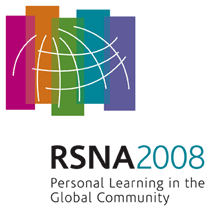
Abstract Archives of the RSNA, 2008
SSQ01-09
Gadobenate Dimeglumine as a Contrast Agent for Dynamic Breast Magnetic Resonance Imaging (MRI): Effect of Higher Initial Enhancement Thresholds on Diagnostic Performance
Scientific Papers
Presented on December 4, 2008
Presented as part of SSQ01: ISP: Breast Imaging (MR Imaging Techniques)
Luca Alessandro Carbonaro MD, Presenter: Nothing to Disclose
Nicola Verardi MD, Abstract Co-Author: Nothing to Disclose
Sara Pedretti MD, Abstract Co-Author: Nothing to Disclose
Giovanni Di Leo, Abstract Co-Author: Nothing to Disclose
Francesco Sardanelli MD, Abstract Co-Author: Consultant, Bracco Group
Gianpaolo Cornalba MD, Abstract Co-Author: Nothing to Disclose
To optimize the diagnostic performance of Gd-BOPTA-enhanced breast MRI.
Fifty-eight patients with 61 breast lesions underwent dynamic breast 1.5-T MRI with 0.1 mmol/kg Gd-BOPTA and 120-s time resolution. Out of 38 malignant lesions, 32 were IDC, 2 DCIS, 2 ILC, 1 infiltrative carcinoma poorly differentiated, 1 mucinous; out of 23 benign lesions, 15 adenosis/fibrosclerosis, 6 typical hyperplasia, 2 fibroadenomas. A score system based on shape (round/oval/lobular = 0; linear/dendritic/stellate = 1), margins (defined = 0; undefined = 1), pattern (homogeneous = 0; inhomogeneous = 1; rim = 2), kinetics (continuous = 0; plateau = 1; washout = 2), and initial enhancement was used. Initial enhancement was determined with standard (<50% = 0; 50-100% = 1; >100% = 2) and adjusted (<180% = 0; 180-240% = 1; >240% = 2) thresholds. Scores 0-2= BI-RADS 2; score 3=BI-RADS 3; score 4-5=BI-RADS 4; score 6-8=BI-RADS 5. Diagnostic performance was assessed using hystopathologic examination (core-, vacuum-assisted, or open biopsy) as a standard of reference. Sign test was used.
Out of 61 lesions, the initial enhancement was >100% for 34 malignant and 18 benign lesions and >240% for 13 malignant (12 IDC and 1 DCIS) and 2 benign lesions (1 fibroadenoma and 1 hyperplasia). The total score was 6.47±0.80 (mean±standard deviation) with standard thresholds and 5.76±1.05 with adjusted thresholds (P<.001) for the 34 malignant lesions while it was 5.52±1.73 and 4.74±1.96 (P<.001) for the 23 benign lesions. With standard thresholds, sensitivity was 100%, specificity 35%, positive predictive value 72%, negative predictive value 100%, and accuracy 79%; with adjusted thresholds, 100%, 65%, 83%, 100%, and 87%, respectively. Six adenosis/fibrosclerosis and 4 typical hyperplasia were false positive with both thresholds. Four adenosis/fibrosclerosis and 1 typical hyperplasia were false positive with standard thresholds but true negative with adjusted thresholds.
The possible negative impact on specificity of the higher relaxivity Gd-BOPTA can be counteracted using higher thresholds for initial enhancement, improving specificity, predictive values, and accuracy without limiting sensitivity.
Breast lesion characterization with Gd-BOPTA requires higher thresholds for initial enhancement than those used with conventional Gd-chelates.
Carbonaro, L,
Verardi, N,
Pedretti, S,
Di Leo, G,
Sardanelli, F,
Cornalba, G,
Gadobenate Dimeglumine as a Contrast Agent for Dynamic Breast Magnetic Resonance Imaging (MRI): Effect of Higher Initial Enhancement Thresholds on Diagnostic Performance. Radiological Society of North America 2008 Scientific Assembly and Annual Meeting, February 18 - February 20, 2008 ,Chicago IL.
http://archive.rsna.org/2008/6020562.html

